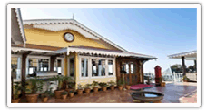|
|
|
| |
Travel destination in India, Gangtok |
| |
[ Book Hotels in Gangtok] |
[ other Travel Destinations in India ] |
| |
General Information about GANGTOK |
Gangtok :
Area : 25 sq.km.
Language : Nepali, Bhutia, Lepcha, Tibetan, English.
Altitude : 1,780 m.
State : Sikkim.
Best Season : April to Mid-June; Mid September to November
STD Code : 3592. |
About Gangtok
Gangtok is the capital and largest town of the Indian state of Sikkim.It is situated in the lower Himalayas, located at 27.2°N 88.4°E. Known for its clean surroundings and temperate climate, this hill station of about fifty thousand people is the centre of Sikkim's tourist industry.Gangtok is a city where you will get to see numerous ancient and modern Monasteries, which are of sheer beauty. Set amidst the majestic mountains and hills along with few lakes at some places Gangtok has numerous places of interest for the tourists.
Gangtok today has become the base from which tourists can plan their exploration of Sikkim at the same time providing a breather from the exhilarating experience of the rest of Sikkim
The town has emerged into the mainstream of the tourism industry with more and more tourists visiting this Himalayan state every year.
CLIMATE
Sikkim has a typical four-season year. The temperature of Gangtok in summer is Max. 210C and Min. 130C and in winter it is Max. 130C and Min. 0.480C. Gangtok records rainfall on an average of 325cm per annum.
HOW TO REACH
By Air : The nearest airport is at Bagdogra which is 125 km from Gangtok. Indian Airlines and Jet Airways connect Bagdogra to Delhi, Guawahati and Kolkata by daily direct flights.
By Rail : New Jalpaiguri is the closest railway station to Gangtok and is located at a distance of 120 km. The drive to Gangtok takes three and half hour.
By Road : Gangtok is connected by National Highway 31A to Siliguri which is 115 km.
PLACES OF ATTRACTION IN GANGTOK
•Do Drul Chorten : Do Drul Chorten is regarded as the most important 'stupa' of Sikkim. It was built in 1945 by Trulshi Rimpoche, head of the Nyingma order of Tibetan Buddhism. The stupa has sacred gold-topped shikhara with 108 prayer wheels. There are two huge statues of Trulshi Rimpoche in the place. It is visited in large numbers by followers of the religion.
•Tashi Ling : The Tashi Ling is another important site to visit in Gangtok. Tashi Ling monastery is best known for its 'Bumchu' (Sacred Pot). This pot contains holy water, which has never run dry for the last 300 years. The place also provides a spectacular view of the Kanchenjunga ranges.
•Namgyal Institute : The Namgyal Institute was built in the year 1958 to promote research in Mahayana Buddhism and Tibetan language and traditions. This institute has been built in traditional style and has the world's largest collection of books and rare manuscripts on Mahayana Buddhism. The institute also houses relics of monks, samples of Lepcha scripts, masks and sacred objects like Kapali.
• Orchid Sanctuary : The Orchid Sanctuary is one of its kind in Sikkim. The sanctuary is famous for its rare and extensive collection of orchids. Although variations are made depending on the season, the wide spread orchid sanctuary has almost 454 species of orchids. The place is a must-see for nature lovers.
• Rumtek Monastery : 24 kms from Gangtok, a drive through beautiful countryside takes one to Rumtek Dharma Chakra Centre built in 1960's by His Holiness the late 16th Gyalwa Karmapa when he took refuge in Sikkim after the Chinese attack. It is an excellent replica of the original Kagyu headquarters in Tibet. It houses some of the world's most unique art objects, ancient manuscripts and icons.
• Changu Lake : With an average depth of 50 ft, this lake is situated at an altitude of 12,000 ft on the Gangtok - Nathu-la highway. |
|
|
|
|
|
|
|







